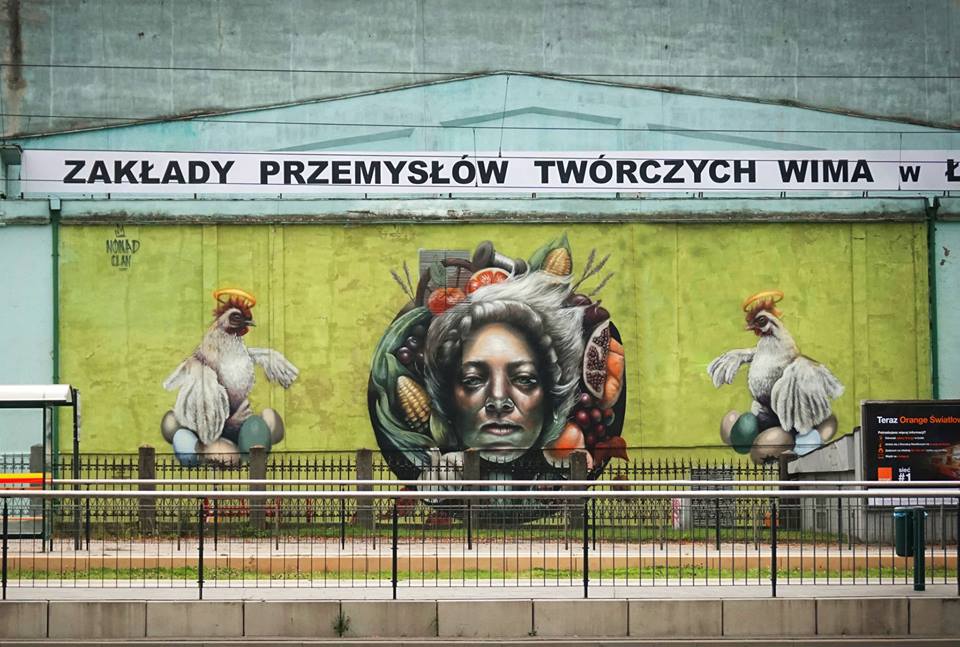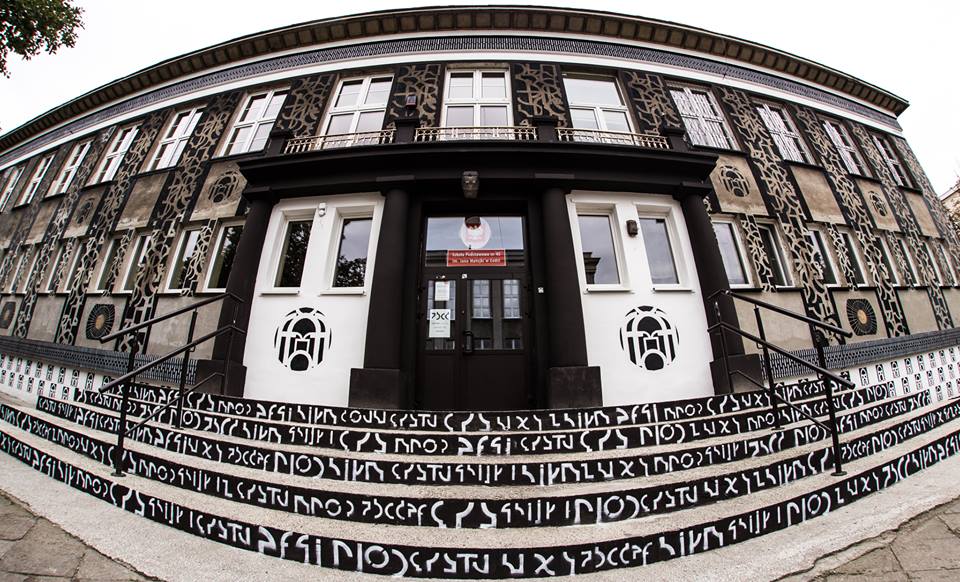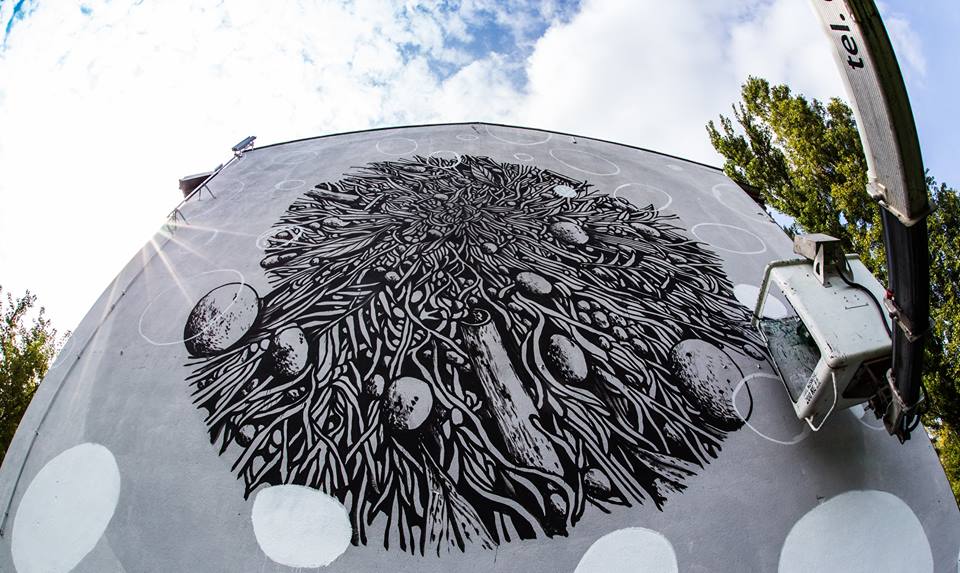
Lodz 4 Cultures Festival is over. This year the event has left some permanent traces in the city space, namely 7 new murals.
Urban Art was a vital part of the whole Festival, therefore interesting artists based in Argentina, Great Britain, Italy, Israel and Poland came to Lodz to participate in the Lodz 4 Cultures Festival.
Alphabet of dialogue.
Urban Art at the Lodz 4 Cultures Festival 2017, Lodz, Poland
Despite the unfavorable weather (rain, rain and even more rain) eleven artistic interventions was carried out. They were inspired both by their locations as well as by the theme of this year’s Festival – „Alphabet of Dialogue”. The fact that the year 2017 is the year of the Avant-garde in Poland was a reason to invite artists who are searching for their own original expressions, not only in forms, but also in artistic creeds. In September 7 murals, two temporary installations and a permanent one appeared in the city area.
Totems of Lodz
Kasia Breska, UK
Lodz, Poland
Urban Forms I Lodz 4 Cultures festival
Most of the citizens know this place very well. It is a yard connecting JaraczaStreet with the infamous „Włókienka” (a place of very bad reputation). An abandoned, destroyed building supported by wooden pieces evokes the image of a graduation tower, hence the popular name of the place – Ciechocinek (a Polish Spa with a large complex of graduation towers). The location inspired Kasia Breska (a female artist based in Leeds, UK) to create a unique, colourful piece, corresponding with the structure of elevation, the rhythm of empty windows or wood logs. For the artist, every space is a special ecosystem, a habitat co-created by human beings, animals, architecture and time. Consisting of geometrical forms and straight graphical signs, „Totems of Lodz” enters into dialogue with its surroundings, as well as with the past and the present of the place.
PH: Karuzela Wspomnień – Agnieszka Kuraszewska
Mokosh in Polish Manchester
Nomad Clan, UK
“Mokosh”
Lodz, Poland
Urban Forms I Lodz 4 Cultures Festival
The strong female team of this year was even strengthened by two British artists – the Nomad Clan. They come from Manchester, that’s why they found their way through the city so easily and appreciated its postindustrial charm.
They dedicated their mural Mokosh (created on the wall of the former factory) to all women as being part of the creation of industrial Lodz. The title is a Slavic mother-goddess, patroness of women and their activities such as spinning and weaving. The opening of the mural was enriched by the energetic concert of the Folk’n Roll team and the performance of the LINEACT group, „Entwined” – showing the ordinary life of spinners of Lodz.

PH: Bokehgo
Dialogue with the architecture
Opiemme, Italy
“Remanufacture”/ “Herring” A Tribute to Wladyslaw Strzemiński
Lodz, Poland
Urban Forms I Lodz 4 Cultures Festival

Although Polish soc-realistic architecture has a group of its devotees, most Polish people do not appreciate it at all. One of its heavy, grey buildings (Primary School nr 45, Bojowników Getta street 3) inspired Opiemme to create two murals, connected by a common motif – strzemienica (fonts invented in the 1930s by a famous avant-garde artist closely connected with Lodz, Władysław Strzemiński). This original font is a repetitive decorative motif on the vertical stripes on the front façade; stairs as well create a frame around the calligram on the back wall of the school. The calligram itself refers to the local motif – The Old Town Park is unofficially called Park Śledzia (Herring Park), due to its functioning as a fish market in the Jewish Area of the city before WW2.
For Opiemme the project was an opportunity to enter into dialogue with architecture, its rhythm, structure and texture. The artist invites pupils of the primary school and students of the 13th Grammar school to participate in a workshop conducted by Qualio team. The result of the workshop is words best expressing the idea of intercultural understanding. The words translated into English, German, Hebrew and Russian, changed into stencils, were used for the sidewalks surrounding the two schools.

PH: Karuzela Wspomnień – Agnieszka Kuraszewska
Deep winter during Indian Summer
Tellas, Italy
“Deep Winter”
Lodz, Poland
Urban Forms I Lodz 4 Cultures Festival


An exceptional Italian artist, Tellas, has created a unique composition on the building belonging to the Medical University, Czechosłowacka street 2a. The artist had been thinking about creating a monochromatic, black and white mural for a long time, but it was not until he found in Lodz the landscape that he could easily incorporate into the piece. Although one can see grass on the pictures, the charm of the mural will be even greater when the snow falls, hence the name of the work: „Deep Winter”.
PH: Tellas
A lacy spiderweb on the old wall
Nespoon, Poland
No title
Lodz, Poland
Urban Forms I Lodz 4 Cultures Festival

The Courtyard at Piotrkowska 3 is well known to the citizens of Lodz. Joanna Rajkowska launched the famous project „Passage of Rose” in 2013, during the Lodz 4 Cultures Festival. Her work was exhibited after a year – countless pieces of mirrors covered the elevations of the building. In 2017 a new work appeared in the same space, this time of more ephemeral character. Nespoon is one of the most recognizable Polish artists creating art in the public space. The material of her installations is yarn or clay. The recurring motif of all her work is lace in which, as the author says, “a universal code, readable all over the world is hidden. In each of them one can find an element of harmony, balance and natural laws. Is it not what we are all looking for?” As a result of her work, the old wall in the city center of Lodz was covered with a mysterious lacy spiderweb, thus becoming another reason to visit the Passage of the Rose and take friends and guests there.

Ph: Karuzela Wspomnień – Agnieszka Kuraszewska
Colours and texture or the beauty of geometry
Moneyless, Italy
No title
Lodz, Poland
Urban Forms I Lodz 4 Cultures Festival

Moneyless comes from Italy. His first steps in the field of art were decorating the walls of his room at the age of three. He had been consistently developing his interests in art and soon became a part of the graffiti scene in Tuscany.
Having finished his studies at the Academy of Fine Arts in Carrara and Florence, he started his artistic interventions in the public sphere. In his installations and paintings he focused on the relationship between the simplicity of geometric composition and the richness of its meanings. In Lodz he created a mural on a somewhat ruined building at the intersection of Wojska Polskiego and Zula Pacanowska streets. He composed his piece into a horizontal partition of the wall thus exposing its heterogeneous texture. The layers, colours, and textures of the work are the language of abstraction used to tell the life cycles of architecture and its inhabitants.
PH: HaWa
Street Games
Hyuro, Argentina
No title
Lodz, Poland
Urban Forms I Lodz 4 Cultures Festival

Pastel colours, large-format paintings by Huyro, an Argentine artist based in Valencia, can be seen all over Europe. This year she came to Poland to take part in Lodz 4 Cultures Festival and created a mural on a wall in Lodz. It reflects her unique style that combines surreal sensitivity with a social and political message. As she says – she is looking for inspiration both in daily observations and in her own inner experiences. “I look into myself and try to analyze. Ordinary fears, apprehensions, questions about identity, freedom – that’s what interests me and I translate it into the language of art.”
PH: HaWa
X on the Old Market Place in Lodz
Robert Rumas, Poland
No title
Lodz, Poland
Urban Forms I Lodz 4 Cultures Festival
Robert Rumas is one of the most eminent Polish artists of 1990s critical art.
This year the artist faced a very difficult task of reviving the space of the Old Market Place in Lodz – a place very special for the inhabitants of the city. Its present form dates from the 1950s and represents the typical urban design of that period. Rumas based his design on four masts, on which he hung up big yellow tapes with quotes from the “Kwiaty polskie” {Polish Flowers}, a poem written by Julian Tuwim – probably the most recognizable poet of Lodz. Apart from the form that itself catches our attention, social and political implications of his work are also very important. “The concept of the installation was inspired by archival photographs upon which a modern form full of hiddenmeanings was designed. It gives an opportunity for reflective distance from the history of this particular place”.
PH: Mikołaj Zacharow
Amazing works and what a great line-up!!
ISSA TEAM

You may consider a modest donation — however much you can afford, when it comes from the heart, it’s the kind of gesture that makes us warm with appreciation.
leave your comment